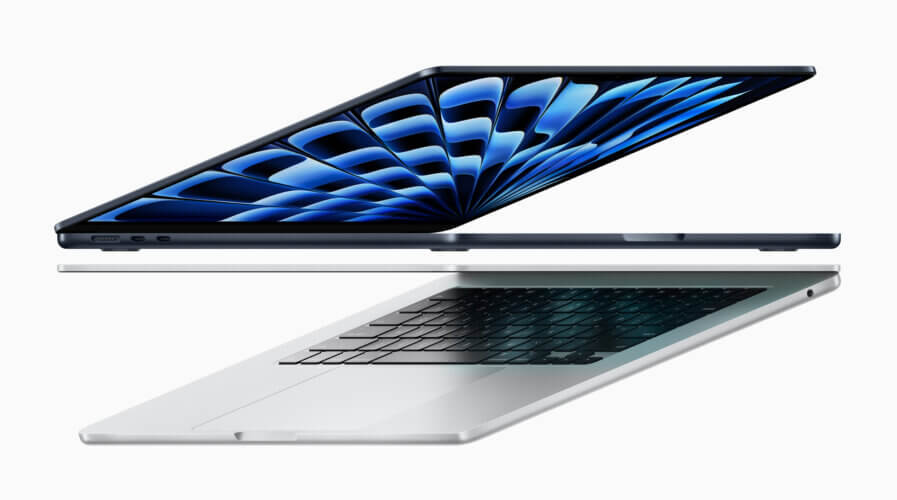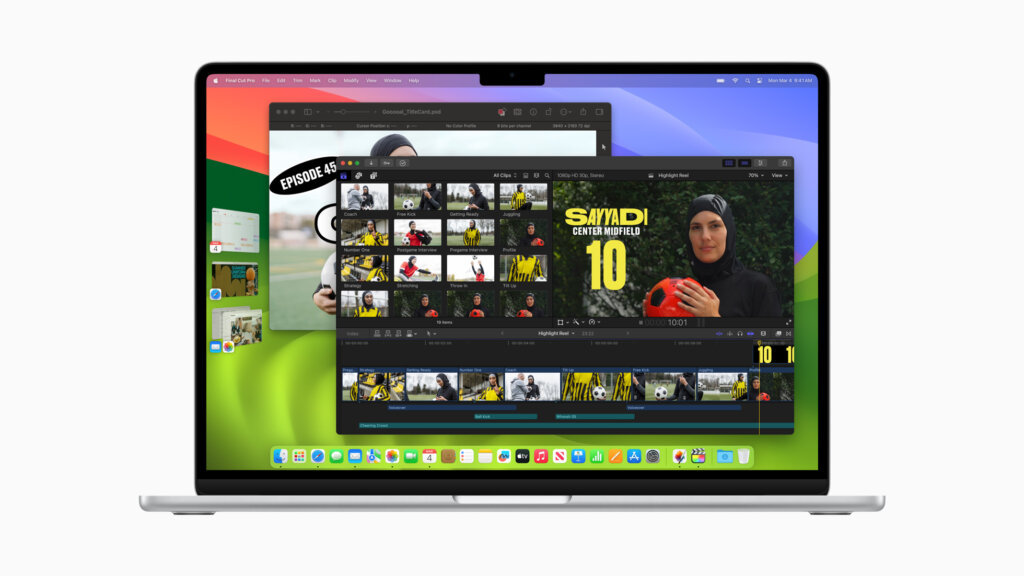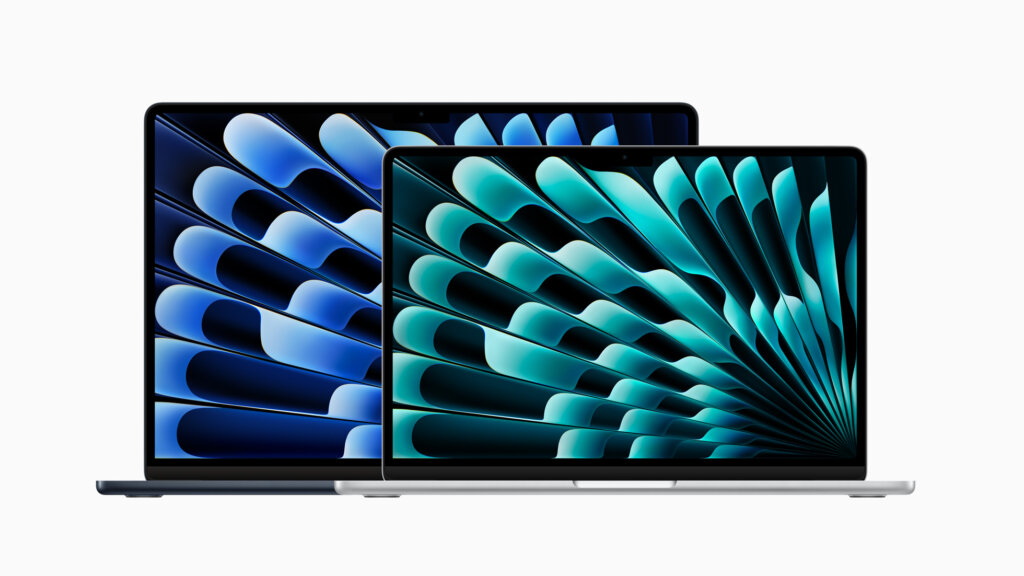
The new 13- and 15-inch MacBook Air soars with the powerful M3 chip. (Source – Apple).
Apple’s new MacBook Air with the M3 chip is finally out – but should you buy it?
- The new MacBook Air with the M3 chip delivers groundbreaking performance.
- It offers up to 60% faster speeds than M1 models and enhanced AI capabilities, making it the pinnacle of consumer laptops for AI to date.
- Choosing between the M2 and M3 MacBook Air involves prioritizing cutting-edge performance and energy efficiency.
Apple recently showcased two new MacBook Air models featuring cutting-edge M3 processors, signaling a strong belief in the appeal of these enhanced models to consumers eager for the latest in AI-enhanced computing technology.
The M3 chip brings a significant performance leap to the MacBook Air, offering speeds up to 60 percent faster than its M1-equipped predecessor and an astonishing 13 times faster than the fastest Intel-based MacBook Air model. Apple has dubbed the M3-powered MacBook Air “the pinnacle of consumer laptops for AI,” thanks to its upgraded, more efficient Neural Engine.
These MacBook Air models are available with either 13-inch or 15-inch displays, both embodying a sleek, lightweight design. They boast up to 18 hours of battery life, a vibrant Liquid Retina display, and new features such as support for dual external displays and wi-fi speeds that double the pace of the previous generation.
In the United States, the pricing begins at US$1,099 for the 13-inch model and US$1,299 for the 15-inch version.
The performance of the M3 MacBook Air
Both models are now open for orders, with shipping expected to start within the week. Since 2020, Apple has shifted to using its proprietary chips, moving away from Intel. This transition towards AI-integrated personal computers is anticipated to contribute to a revival in the PC market by 2024, following a slump lasting over two years after the pandemic.
Apple reported a slight increase in Mac sales, totaling US$7.78 billion in the most recent quarter, following a significant downturn in the quarter before.
Delving deeper into the M3 chip’s specifics, it uses groundbreaking 3-nanometer technology, significantly enhancing the MacBook Air’s performance and capabilities. The chip has an 8-core CPU, up to a 10-core GPU, and can support up to 24GB of unified memory. This setup ensures the MacBook Air is not only up to 60 percent faster than the M1 model but also maintains up to 18 hours of battery life, significantly longer than its Intel-based counterparts, letting users experience the M3’s speed across various activities, from routine tasks to more demanding endeavors like photo and video editing or software development.
The M3 chip also introduces a new generation GPU that supports advanced gaming features like hardware-accelerated mesh shading and ray tracing, leading to highly realistic gaming experiences. It also enhances video quality with its latest media engine, that supports AV1 decode, ensuring efficient and high-quality streaming.
With the M3 chip, MacBook Air’s performance is elevated in several ways, including faster AI-enhanced image processing with Photomator’s Super Resolution, quicker Excel spreadsheet management, and superior performance and battery life compared to laptops with Intel Core i7 processors.

The power-efficient M3 chip brings more speed to everything users do, including working on demanding tasks like photo and video editing. (Source – Apple).
Choosing between M2 and M3
When considering whether to opt for the M2 or M3 MacBook Air, it’s clear that the M3 chip offers significant advancements. Benchmark tests reveal that the M3 outperforms the M2 in single-core tasks by around 17% and in multi-core tasks by roughly 21%. Its GPU performance also sees a 15% improvement over the M2. The M3 introduces a new GPU architecture, including Dynamic Caching, for optimized memory allocation, benefiting performance and energy efficiency. This is especially advantageous for graphics-intensive applications.
Despite the similarities between the 16-core Neural Engine of the M2 and M3, the M3’s 3nm fabrication process enhances the execution of machine learning and AI tasks more efficiently. It also maintains up to 24GB of unified memory, but utilizes the new process for improved memory bandwidth utilization.
The energy efficiency of the M3 chip is another highlight, offering higher performance without significantly increasing power consumption. This makes it especially attractive for laptop users who prioritize a balance between power and battery life.
While the M3 chip is undeniably an upgrade from the M2, with its higher transistor count and enhanced CPU and GPU performance, the necessity of an upgrade for current M2 users depends on their specific needs. For new purchasers or those upgrading from older models, the M3’s improvements will be distinctly beneficial.

Available in two perfect sizes, the MacBook Air delivers the ultimate in portability. (Source – Apple).
A personal take on the M2 vs M3 decision
Discussing personal perspectives on choosing between the M2 and M3 chips, it’s evident that these laptops, particularly the 15-inch M3 MacBook Air priced at US$1,299, reflect the cost of technological advancements. The 13-inch M3 model starts at US$1,099, matching the M2’s launch price in 2022. However, two years post-launch, the M2 is now available for US$999.
Opting for the M3 model brings the fastest wi-fi support, crucial for heavy downloading tasks or gaming, thanks to the new wi-fi 6e standard. The M3’s superior performance, particularly for AI applications and demanding tasks like video editing or graphic design, makes it a worthy investment for those seeking the best available technology.
Conversely, for users whose primary activities include web surfing, streaming, and remote work, the M2 MacBook Air offers a reliable and more affordable option.
The M3 MacBook Air’s launch isn’t just exciting news for the tech world; it’s the dawn of a new chapter in personal computing. With significant leaps forward in speed, efficiency, and technological innovation, we’re not just looking at what meets the tech-savvy user’s needs today. Apple is laying the groundwork for the digital future we’re all heading towards.
So, when you’re considering which MacBook Air to go for, the M2 or the M3, remember that Apple has something for everyone. Each model offers a unique blend of style, performance, and features, ensuring that your choice isn’t just about picking a device—it’s about choosing your next companion on oyur digital journey. It’s more than a decision between specs; it’s about selecting the perfect partner for wherever your digital adventures might take you.
READ MORE
- Safer Automation: How Sophic and Firmus Succeeded in Malaysia with MDEC’s Support
- Privilege granted, not gained: Intelligent authorization for enhanced infrastructure productivity
- Low-Code produces the Proof-of-Possibilities
- New Wearables Enable Staff to Work Faster and Safer
- Experts weigh in on Oracle’s departure from adland


